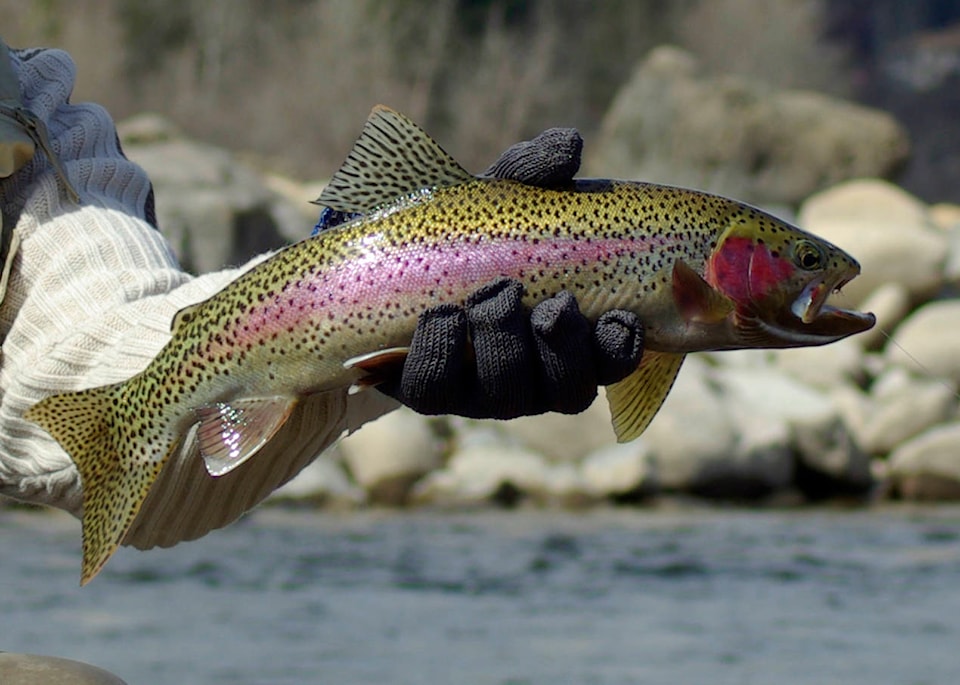For almost 30 years between the months of March and June, BC Hydro has kept its flows on the Columbia River at a stable level to protect spawning rainbow trout.
But BC Hydro announced last week, that it will alternate years of protection flows and non-protection flows to see if the flow regime is actually benefitting adult rainbows, or if there are other environmental factors in play.
Related read: Pike suppression continues on Columbia
Prior to 1992, the spring discharge below Hugh Keenleyside and Brilliant Dams involved gradually decreasing flows during the rainbow trout spawning months that resulted in thousands of stranded rainbow trout redds (eggs).
Since BC Hydro began regulating flows to prevent redd dewatering, the trout population has grown at least 10-fold; but that’s all changing.
“There was not a lot of information known about rainbow trout spawning in the Lower Columbia River in the 1990’s when the rainbow trout protection flows first began,” said BC Hydro stakeholder advisor Jen Walker-Larsen. “Although these flows were implemented in 1992 in response to a rainbow trout redd stranding incident, there was not good data collected at the time on how many eggs were stranded nor the impact of that stranding event on the rainbow trout population.”
During regulated seasons, discharges are reduced in March to encourage rainbow trout to spawn at lower elevations and avoid dewatering when and if the river fluctuates.
According to BC Hydro, the flows are negotiated annually in the fall with the United States under the Columbia River Treaty as part of the Non-Power Uses Agreement (NPU).
“Under the NPU, Arrow flows are modified for Canadian mountain whitefish and rainbow trout spawning protection flows in exchange for summer flow increases for salmon spawning in the United States. The ability to target rainbow trout protection flows in exchange for summer flow increases for spawning salmon in the U.S..”
A 10-year Lower Columbia River Rainbow Trout Spawning Assessment wrapped up last year, and confirmed annually the unequivocal growth of the rainbow spawning populations; however, that was with the regulated flows in place.
Ironically, the spawning program may have been too successful. The trout population may be too big, and there are growing concerns with the health of the adult trout, and whether the population is at risk of reaching a tipping point, much like the Gerrard rainbow and Kokanee populations did on Kootenay Lake.
Related read: New regulations to boost Kootenay Lake kokanee recovery
“Alternating years of fish protection flows and no protection flows will allow us to see if the rainbow trout protection flows are actually benefitting the adult rainbow trout population,” said Walker-Larsen. “Our rainbow trout models suggest that the impact of this test on the rainbow trout population will likely be very small.”
Every year, the ability to satisfy BC Hydro’s objectives is dependent on Mother Nature, and how much water is in the system based on the snowpack and spring runoff. The development of eggs and fry (young fish) are strongly linked to flows and water temperatures.
Yet, historically, many factors impacted rainbow trout spawning, including industrial and agriculture pollution, introduction of invasive species, and disruption of suitable spawning habitat. The new study hopes to determine just how much regulated flows contributes to the rainbow boom on the Columbia.
“Although we know the flows have protected virtually all eggs from dewatering, we do not have a good grasp on whether enhanced egg survival from the protection flows is the reason for the increasing rainbow trout population,” continued Walker-Larsen. “For many fish species, the vast majority of eggs laid do not produce adult fish and a lot can happen after a rainbow trout egg hatches that affects how many grow to adulthood.”
With the alternating flow regime and further study, BC Hydro hopes to ensure a healthy rainbow trout population, now and for the future.
